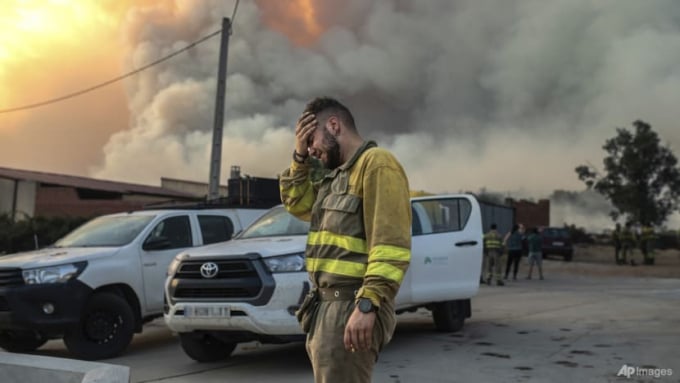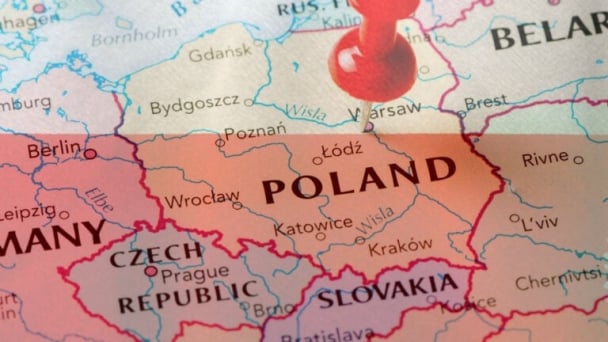June 21, 2025 | 01:15 GMT +7
June 21, 2025 | 01:15 GMT +7
Hotline: 0913.378.918
June 21, 2025 | 01:15 GMT +7
Hotline: 0913.378.918

A firefighter cries near a wildfire in the Losacio area in north western Spain on Sunday July 17, 2022. Photo: Emilio Fraile/Europa Press via AP
Hundreds of millions of people struggled to keep cool amid a sweltering summer heat wave as cities across the United States and mainland Europe experienced record-high temperatures. In the United Kingdom, thermometers topped 40 degrees Celsius on Tuesday (Jul 19), the highest ever recorded.
While all this broiling heat is surely punishing on a personal level, it also has significant impacts on the broader economy.
As an economist who has studied the effects of weather and climate change, I have examined a large body of work that links heat to economic outcomes. Here are four ways extreme heat hurts the economy.
Research has found that extreme heat can directly hurt economic growth.
For example, a 2018 study found that the economies of US states tend to grow at a slower pace during relatively hot summers. The data shows that annual economic growth falls 0.15 to 0.25 percentage points for every 1 degree Fahrenheit (0.56 degrees Celsius) that a state’s average summer temperature is above normal.
Laborers in weather-exposed industries such as construction work fewer hours when it’s hotter. But higher summer temperatures also reduce growth in many industries that tend to involve indoor work, including retail, services and finance. Workers are less productive when it’s hotter out.
Agriculture is obviously exposed to weather: After all, crops grow outdoors.
While temperatures up to around 85 F to 90 F (29 degrees Celsius to 32 degrees Celsius) can benefit crop growth, yields fall sharply when thermostats rise further. Some of the crops that can be hit hard by extreme heat include corn, soybeans and cotton.
These reductions in yields could be costly for US agriculture. For example, a recent study I conducted found that an additional 2 degrees Celsius of global warming would eliminate profits from an average acre (about 4050 sq m) of farmland in the eastern US.
A prominent example of this was the collapse of the Russian wheat harvest in response to the country’s 2010 heat wave, which raised wheat prices throughout the world.
Of course, when it’s hot, energy use goes up as people and businesses run their air conditioners and other cooling equipment at full blast.
A 2011 study found that just one extra day with temperatures above 90 F (32 degrees Celsius) increases annual household energy use by 0.4 per cent. More recent research shows that energy use increases the most in places that tend to be hotter, probably because more households have air conditioning.
This increase in electricity use on hot days stresses electric grids right when people depend on them most, as seen in California and Texas during past heatwaves.
Blackouts can be quite costly for the economy, as inventories of food and other goods can spoil and many businesses either have to run generators or shut down. For instance, the 2019 California blackouts cost an estimated US$10 billion.
A long-term impact of increasingly hotter weather involves how it affects children’s ability to learn – and thus their future earnings.
Research has shown that hot weather during the school year reduces test scores. Math scores decrease more and more as the temperature rises beyond 70 F (21 degrees Celsius). Reading scores are more resistant to high temperatures, which this research claims is consistent with how different regions of the brain respond to heat.
One study suggested that students in schools that lack air conditioning learn 1 per cent less for every 1 degree Fahrenheit increase in the school year’s average temperature. It also found that minority students are especially affected by hotter school years, as their schools are more likely to lack air conditioning.
Lost learning results in lower lifetime earnings and hurts future economic growth.
The impact of extreme heat on development, in fact, begins before we’re even born. Research has found that adults who were exposed to extreme heat as foetuses earn less during their lifetimes. Each extra day with average temperature above 90 F (32 degrees Celsius) reduces earnings 30 years later by 0.1 per cent.
AIR CONDITIONING CAN HELP TO A POINT
Air conditioning can offset some of these effects. For example, studies have found that having a working air conditioner means fewer people die, student learning isn’t compromised and extreme heat outside during pregnancy doesn’t hurt foetuses.
Not everyone has air conditioners, however, especially in states such as Oregon and countries such as the UK that have more temperate climates but have nonetheless recently experienced unusually extreme temperatures.
And many people can’t afford to own or operate them. Survey data from 2017 found that around half of homes in the US Pacific Northwest lacked air conditioning. And about 42 per cent of US classrooms lack an air conditioner.
While heat waves are shown to induce more households to install air conditioning, it’s hardly a panacea. By 2100, higher use of air conditioning could increase residential energy consumption by 83 per cent globally. If that energy comes from fossil fuels, it could end up amplifying the heat waves that are causing the higher demand in the first place.
And in the US South, where air conditioning is omnipresent, hotter-than-usual summers still take the greatest toll on states’ economic growth.
In other words, as temperatures rise, economies will continue to suffer.
(CNA)

(VAN) Poultry production in Poland, which has only started recovering from devastating bird flu outbreaks earlier this year, has been hit by a series of outbreaks of Newcastle disease, with the veterinary situation deteriorating rapidly.

(VAN) Extensive licensing requirements raise concerns about intellectual property theft.

(VAN) As of Friday, a salmonella outbreak linked to a California egg producer had sickened at least 79 people. Of the infected people, 21 hospitalizations were reported, U.S. health officials said.

(VAN) With the war ongoing, many Ukrainian farmers and rural farming families face limited access to their land due to mines and lack the financial resources to purchase needed agricultural inputs.

(VAN) Vikas Rambal has quietly built a $5 billion business empire in manufacturing, property and solar, and catapulted onto the Rich List.

(VAN) Available cropland now at less than five percent, according to latest geospatial assessment from FAO and UNOSAT.

(VAN) Alt Carbon has raised $12 million in a seed round as it plans to scale its carbon dioxide removal work in the South Asian nation.